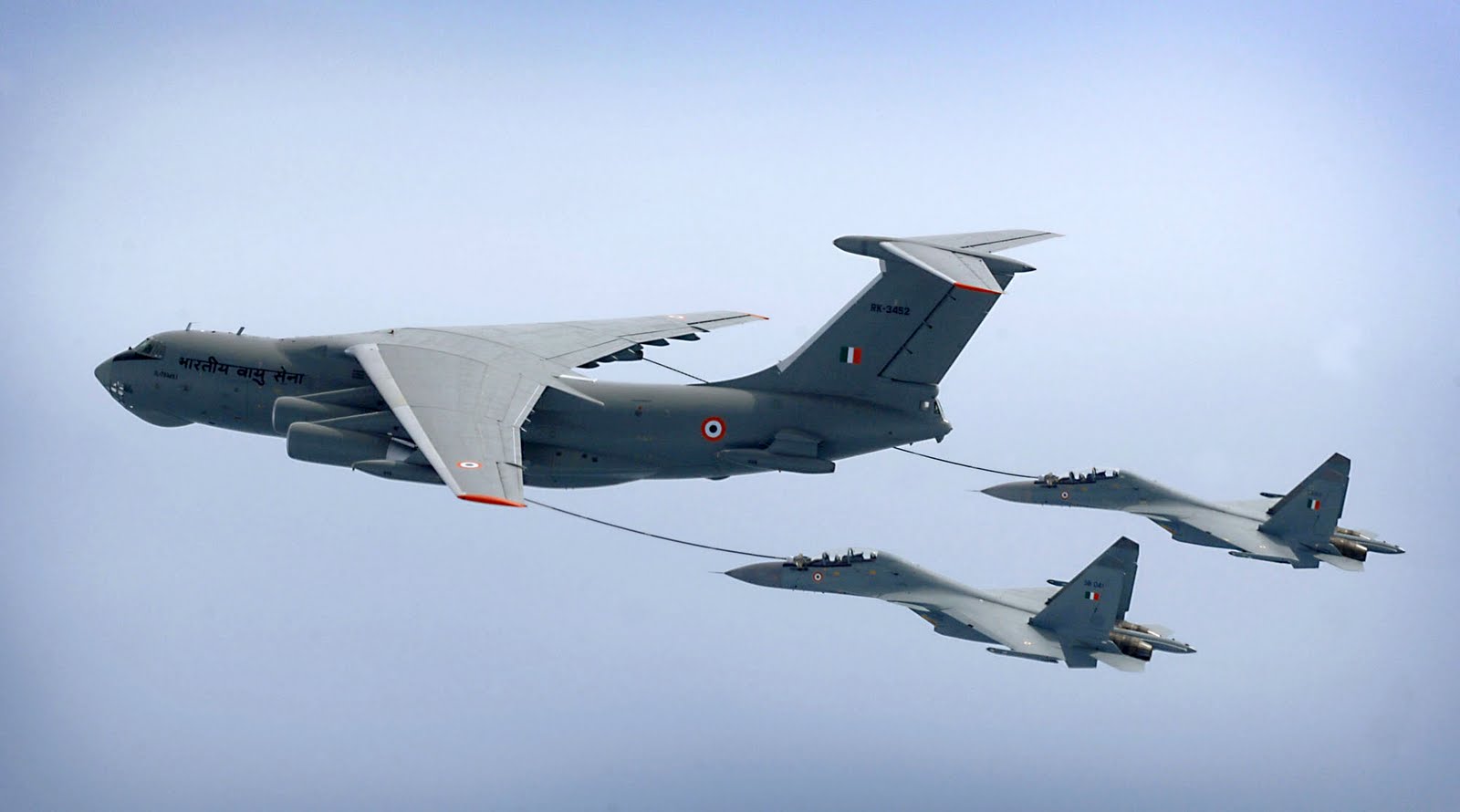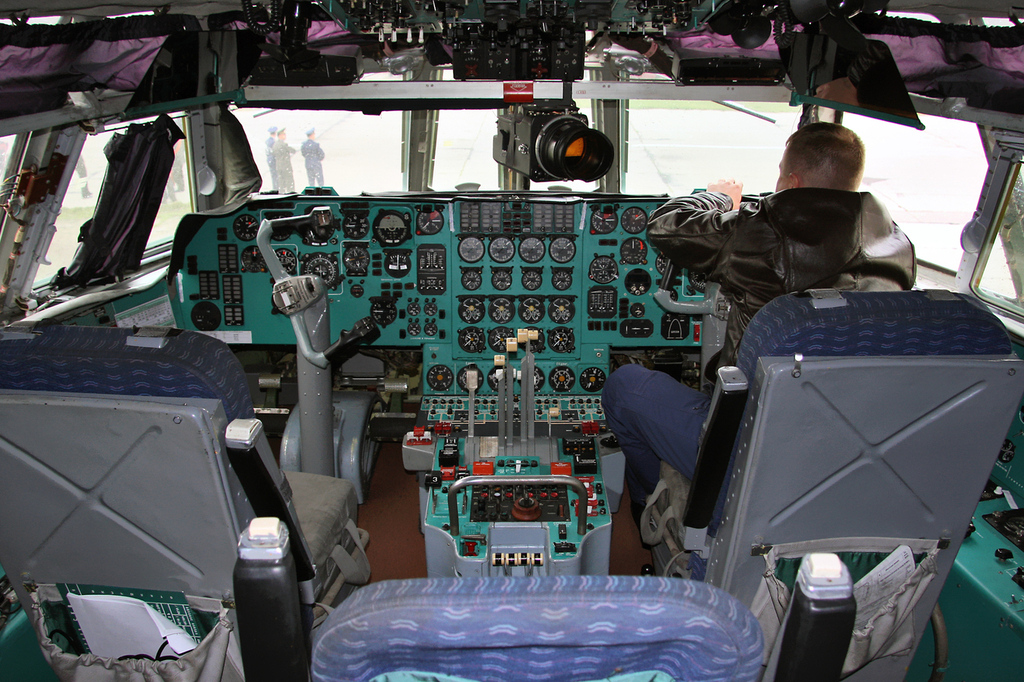IL-78 Midas Air-to-Air Refuelling / Transport Aircraft, Russia
Design and development
IL-78 Midas from 203rd Guards Air Refuelling Regiment
The Il-76 tanker was conceived as long ago as 1968, but the transferable fuel load for the initial version was only 10 tonnes, which was insufficient, so development was shelved. When the higher performance Il-76 became available the tanker project was restarted in 1982 as the Il-78.
In addition to the increased fuel load of the late model Il-76, the Il-78 has two removable 18,230-liter fuel tanks installed in the freight hold, giving transferable loads of 85,720 kg (188,980 lb) (with hold tanks) or 57,720 kg (127,250 lb) (without). Controlled from the gunner station, which is stripped of military equipment, three aircraft can refuel in flight simultaneously from the UPAZ-1A (Il-78) / UPAZ-1M (IL-78M) 26m refuelling pods fitted to the outer wings and rear fuselage. In addition, four aircraft can also be refuelled on the ground using conventional refuelling hoses extending from the freight hold. Because of the aircraft's high all-up weight after take-off, which in an emergency would mean landing at weights well in excess of maximum allowable landing weight, the Il-78 has a fuel jettison system with jettison ports at the wingtips.
Soon after the Il-78 passed acceptance tests in 1984, Ilyushin was instructed to design and produce an upgraded version to be known as Il-78M. The Il-78M is a dedicated tanker and cannot be converted back to the transport role easily. Adding a third freight hold tank increased transferable fuel to 105,720 kg (233,070 lb) and maximum take-off weight (MTOW) to 210,000 kg (460,000 lb), necessitating reinforcement of the wing torsion box. UPAZ-1M refuelling pods improved maximum fuel flow to 2,900 l/min [2] (638 Imp gal/min). Because the Il-78M is not "convertible", all cargo handling equipment was removed and cargo doors were deleted, saving approximately 5,000 kg (11,000 lb) in structural weight.
Early versions of the Il-78 have the fuselage pod mounted on a short horizontal pylon, but the Il-78M has the fuselage pod suspended from an identical pylon to the wing pods, attached to a short stub wing. This modification was served to isolate the pod from turbulence generated by the fuselage, with the added benefit of commonality with the wing pod/pylon combination. Some Il-78s were produced with Aeroflot colours and civilian registrations, but production Il-78Ms received military markings, registration and colour scheme.
The majority of the twenty Il-78 aircraft of the Ukrainian Air Force have been permanently converted to pure transports, freight hold tanks and refuelling equipment being removed.
IL-78 aerial refuelling tanker variants
The IL-78 has five variants, namely IL-78T, IL-78M, IL-78ME, IL-78MKI, and IL-78MP.
IL-78T is an alternative version of the IL-78 primarily used for holding all cargo handling equipment and convertible freight.
Another variant, the IL-78M, is a consecrate tanker aircraft designed to perform only refuelling operations without being able to be converted into transport aircraft. It is equipped with three permanent fuselage tanks. The IL-78M took its maiden flight on 7 March 1987.
The IL-78ME is an export version of IL-78M.
The IL-78MKI is a tailor-made variant of IL-78M and is equipped with Israeli fuel-transferring systems. These aircraft were deployed by the Indian Air Force (IAF) and can refuel six to eight Sukhoi Su-30MKIs in a single operation. The variant took its maiden flight on 11 January 2003.
The IL-78MP is a multipurpose aerial-refuelling tanker or transport aircraft. It is fitted with removable fuel tanks in the cargo hold and UPAZ refuelling pods.
These aircraft are deployed by the Pakistani Air Force (PAF) and can be easily converted to transport aircraft by removing the fuel tanks.
Midas orders and deliveries
In December 2008, the PAF signed an agreement with Ukraine to procure four IL-78 refuelling aircraft equipped with Russian-designed UPAZ refuelling pods.
The first IL-78 aircraft was delivered in December 2009. The second was delivered in 2010 and the third tanker in February 2011. The fourth is yet to be delivered.
The Indian Air Force (IAF) placed an order for six IL-78s in 2003. The first refuelling aircraft equipped with Israeli-made aerial refuelling pods was delivered to IAF in March 2003. The IL-78 has a total fuel carrying capacity of 110,000kg.
The deliveries to IAF were completed in 2004. The aircraft have been deployed at the Agra Air Force Base in India.
The People's Liberation Army Air Force procured four IL-78s in 2005. The Russian and Ukrainian Air Forces operate 19 and eight IL-78 aircraft respectively.
IL-78 cockpit
The IL-78 has a glass cockpit that features five seats for two pilots, a communication officer, a navigator and a flight engineer. The two pilots sit at the front of the cockpit and just behind it is a seat reserved for the flight engineer. The outer corner of the flight engineer's seat is meant for the communication officer. One deck below the glass nose is the navigator's chair.
Avionics
The avionics of the IL-78 include an integrated (automated) flight control and navigation system with a compass system, ground surveillance radar, a central digital computer, an automatic monitoring (AMS) and automatic flight control system (AFCS), a short-haul radio navigation and landing system, an identification friend or foe transponder (IFF), an optical / infrared aiming sight and a ground collision warning system (GCWS).
Other avionics installed in the aircraft include distance measuring equipment (DME), dual very-high-frequency (VHF) navigation / communication and X-band colour weather radar in the nose.
It is also fitted with a traffic collision avoidance system (TCAS), a global positioning system (GPS), a cockpit voice recorder / flight data recorder (CVR/FDR), an instrument landing system (ILS) and a tactical aid for navigation (TACAN) system.
Cargo
Six crew and up to 138,000kg cargo can be carried on the cargo deck above the refuelling systems.
Aviadvigatel D-30 KP turbofan engines
The IL-78 is powered by four Aviadvigatel D-30 KP turbofan engines. Each engine can produce a maximum take-off thrust of 118kN. It is a two-shaft, low-bypass turbofan engine equipped with two spool compressor and mixed flow.
The D-30 KP turbofan engine is primarily used for short-haul airplanes for passenger transportation. The length and fan tip diameter of the engine are 3.98m and 1.05m respectively.
IL-78 performance
The IL-78 can fly at a maximum speed of 850km/h. The range and service ceiling of the aircraft are 7,300km and 12,000m respectively. The aircraft weighs around 72,000kg and the maximum take-off weight is 210,000kg.
Source
Here goes the code of the element you want to show


